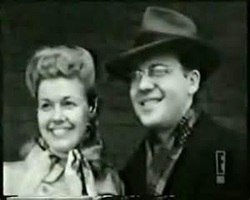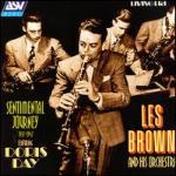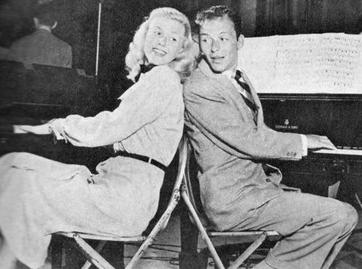"I first met Doris Day when I was singing with my three brothers on radio station WLW in Cincinnati, Ohio. I was 14 years old. I had a crush on her then and I still do. She had a voice so fresh you could smell it. She's a terrific singer and a great lady."
- Andy Williams
"The happiest times in my life were the days when I was traveling with Les Brown and his band." - Doris Day
- Andy Williams
"The happiest times in my life were the days when I was traveling with Les Brown and his band." - Doris Day
The Definitive Musical Sound of Doris Day

When Doris Day sings a song, whether it is on a record or a radio/TV show or even in a film, the listener takes it very personal. After all, that listener remarks, “she is singing directly to me”.
It has always been that way…right at the very beginning. When she sang for her first music teacher, Grace Raine, the teacher imparted that lesson to her. And the teacher was so impressed with the results that she got Doris her first jobs, both on radio and with bandleader, Barney Rapp, who changed her name after the way she sang a song called “Day After Day”. The singing had its magic way back then.
It has always been that way…right at the very beginning. When she sang for her first music teacher, Grace Raine, the teacher imparted that lesson to her. And the teacher was so impressed with the results that she got Doris her first jobs, both on radio and with bandleader, Barney Rapp, who changed her name after the way she sang a song called “Day After Day”. The singing had its magic way back then.
Below is an interesting image found in an internet search. It advertises two separate performances about 5 months apart (1938-1939) but notice the coincidences. Not long after, it was Doris with Les.

Doris with bandleader Bob Crosby, brother of Bing.
After the time spent with Barney Rapp, Doris also worked briefly with The Jimmy James Orchestra and for three months with Bob Crosby and his Bobcats. No known recorded material exists from her time with either James or Crosby. Some bios also list a brief spell with Fred Waring and his Orchestra, but that has never been discussed by Doris in any books we have read or interviews we have heard.
The magic continued when she performed with the Les Brown Band, on and off for 6 years.
"She was every bandleader's dream, a vocalist who had natural talent, a keen regard for the lyrics and an attractive appearance." - Les Brown
"She was every bandleader's dream, a vocalist who had natural talent, a keen regard for the lyrics and an attractive appearance." - Les Brown
During that time, she had 15 sides that were in the Top 10, two of which were signature tunes for her at the time. “Sentimental Journey” is still mentioned when a discussion of the end of World War II comes up; it was the perfect song, the perfect singer, the perfect record to end the war and bring the guys back home. Doris and Les followed that almost immediately with “My Dreams Are Getting Better All The Time”, which knocked “Journey” out of its first place slot on the hit lists.
To those gigantic hits before 1947, listen to this medley of some of the other top ten songs associated with Les Brown and Doris that helped to establish the Doris Day Sound…the voice may be young at the time, but the vocal quality is as clear as a bell:
These songs were among the ones that charted in the Top 20 in the mid 40's for Les and Doris:
“I Got the Sun in the Morning and the Moon at Night”
“The Whole World is Singing My Song”
“Day By Day”
“You Won’t Be Satisfied (Until you Break My Heart)
“Till the End of Time”
“Come To Baby Do”
“Sooner or Later”
“It Could Happen To You”
Also, while singing with the Les Brown Band, Doris was one of the first female vocalists to appear in musical soundies, an early form of MTV. Check out this one:
“I Got the Sun in the Morning and the Moon at Night”
“The Whole World is Singing My Song”
“Day By Day”
“You Won’t Be Satisfied (Until you Break My Heart)
“Till the End of Time”
“Come To Baby Do”
“Sooner or Later”
“It Could Happen To You”
Also, while singing with the Les Brown Band, Doris was one of the first female vocalists to appear in musical soundies, an early form of MTV. Check out this one:
Although Doris prefers to sing a slow ballad and she thinks that she does that best of all, others disagree and say she can sing anything with the best of them, slow or fast. That could be seen very quickly on her first few hits. Her first “single” hit recording was on a polka called “Papa, Won’t You Dance With Me”, followed by a duet with Buddy Clark on a double-sided million seller called “Love Somebody” and “Confess”.
The listener did not have to see Doris to appreciate the beauty of her golden voice, what some have called a voice of velvet. But once you add THE LOOK to the VOICE, as Frank Sinatra said on YOUR HIT PARADE, “You’re hooked because Doris Day’s got the drop on you!” Doris co-hosted that popular radio show with Sinatra in 1947 and got the opportunity to sing lots of songs …songs she never recorded, mostly lost to posterity.
Fortunately for Doris fans, not all of the songs were lost. Listen, as Frank introduces Doris to sing a couple of the popular songs of the time, from radio transcripts, now preserved on YouTube.
|
|
|
|
At the same time that Doris was doing Your Hit Parade, she was also featured on several radio shows, most significantly with Bob Hope whose background orchestra was Les Brown…small world! She continued appearing on the Hope Shows through 1949, often traveling with Bob and Les to entertain the troops. (Incidentally, it was at this time, after some pretty shaky flights, that Doris developed a fear of flying, which persists to the present day.)
On the road with Bob Hope and Les Brown
Here, from one of those weekly Hope shows, are Bob and Doris dueting on a song they never recorded together .
Here, from one of those weekly Hope shows, are Bob and Doris dueting on a song they never recorded together .
Doris was never one to sit around and rest. In the spur of all this activity, she was busily making her first movie “Romance on the High Seas” in 1948.
Musically, we see and hear Doris for the first time on film with an uptempo song called “I’m in Love, I’m in Love”. Then comes a beautiful ballad called “It ‘s You or No One For Me”. Next, Doris goes into jazz/swing mode with “Put ‘Em in a Box, Tie ‘em With a Ribbon, and Throw ‘em in the Deep Blue Sea”. Here is a brief medley of those songs:
But the icing on the cake was a little song called “IT’S MAGIC” sung several times in the film.
Each time, the listener sits straight up and becomes totally enraptured. Comedienne and TV star Betty White says of the song, “Every time Doris sang that song I got into trouble!” Actually, all the songs from this film, released as singles, were hits, especially on the 1948 jukeboxes.
After SENTIMENTAL JOURNEY in 1945, and only three years later, Doris had another signature song, one that she continued to sing many different ways through the years. Let’s see….
After SENTIMENTAL JOURNEY in 1945, and only three years later, Doris had another signature song, one that she continued to sing many different ways through the years. Let’s see….
From 1948 up to 1950, Doris had over 15 songs that hit the Top 20. One thing that music researchers tend to forget is that not all songs become #1. Many never get higher than 2 or 3 in the Top Ten. That does not mean they should be ignored. One example is another signature tune that Doris recorded with the Mellomen. It peaked at #2, but it charted for over 19 weeks. It was called “Again”. The flip side, “Everywhere You Go” also charted. (While Vic Damone also had a recording of “Again” that charted well. It is the Day version that gets the historical nod.) "Everywhere You Go" is a song that perfectly fits the personality of Doris herself and reflects the sunshine that pours out in her singing.
|
|
|
Another very important factor we need to consider when discussing Doris Day music is the importance of both radio and jukebox plays. More than once Doris was selected by national disc jockeys as their favorite performer, and they gave her a lot of air play. Her records were consistently on the American jukeboxes as well. Chart lists are usually determined by sales and rarely include the number of nickels (the cost per single play at that time) spent to play certain songs. Many of the songs were very popular on the national jukeboxes but did not sell well for obvious reasons. If one could play it on the jukebox anytime, there was no need to buy it. One such song was the pairing of “My Dream is Yours” (title song from her second movie in 1949) with “Someone Like You” (also from the film). Both sides were big jukebox hits that did not chart in the Top 20 in record sales. In fact, Someone Like You was recently resurrected for a dog commercial…. Not to be confused with another current song with the same title by Adele. The song that DID chart from the movie was called “Canadian Capers (Cuttin’ Capers)” which rode the sales charts for at least 10 weeks, remaining on jukeboxes for over a year. These three songs from the movie alone show the infinite variety in the musical style of Doris:
Several other songs placed on various music charts in 1948 and 1949. Buddy Clark & Doris Day hit with "I'll String Along With You". With The Modernaires, Doris pulled many spins on a little song called "Thoughtless". And she even tried a country mode with a group called "Her Country Cousins". "Quicksilver" hit the Top 20, but other chart entries included: "The Game of Broken Hearts", "I'll Never Slip Around Again" and "Crocodile Tears".
The following stills are from the the 1949 film, along with the lobby card:
The following stills are from the the 1949 film, along with the lobby card:
In 1949, there was yet another film, "It's A Great Feeling", her third with Jack Carson as co-star.
Doris is here disguised as a French Chanteuse
Once again, the title song became associated with Doris. It may not have charted in the top 10, but it was nominated for an Academy Award that year and received lots of air and jukebox play, as well as two other songs from the film: “At The Café Rendevous” (on which Doris sports a French Accent) and a beautiful ballad called “Blame My Absent-Minded Heart.”
|
|
|
|
One of the songs Doris recorded in 1949 came from the Betty Hutton movie, “Red, Hot and Blue”. And although Betty had recorded the song, the release by Doris on the flip side of “Blame my Absent-Minded Heart” is the one that became the big Top 20 Hit. It was called: “(Where Are You) Now That I need You”.
Although movie songs were making inroads on the pop charts and jukeboxes for Doris, duets were also a big part of her popularity between 1948 and 1950. Here we see Doris with her most consistent co-star on hit records, Buddy Clark, who died in a plane crash in 1949:
She recorded more than 10 songs with Buddy Clark, three of which reached the top 20: “That Certain Party”, “Powder Your Face with Sunshine” and “My Darling, My Darling”. In addition, she also had other duets in 1949: one with Frank Sinatra reached the Top 20. It was called “Let’s Take an Old Fashioned Walk” from the Broadway show, “Miss Liberty”. Two others were recorded with Dinah Shore, the top female vocalist at Columbia Records when Doris arrived in the fold. By the end of 1949, Doris was #1 and Dinah had slipped. “Better to Conceal” was a fun song that got some jukebox play, along with the ballad “You Can Have Him” also from “MISS LIBERTY”. Next up, a medley of those duets in condensed format:
Another aspect of the Doris Day musical personality involves her uncanny ability to sell a novelty or silly song. Here is how Doris probably reacted to most of those silly songs she was asked to record:
She always gave each musical performance 100 percent, whether she liked a song or not. The fact that she did so well with a novelty song could explain why Columbia Records had her perform so many of them throughout her career. Although there were others before this, Doris ushered in 1950 with several novelty songs. One of them came towards the end of ‘49 called “Bluebird On Your Windowsill”. Both that, and the flip side, “The River Seine” hit the charts. Not long after that came a raft of novelty songs, mostly in 1950. These included: “I Said My Pajamas”, “Enjoy Yourself (it’s Later Than You Think), “Hoop Dee Doo”, “A Bushel and a Peck”, “Quicksilver” and “I Didn’t Slip-I Wasn’t Pushed-I Fell”. All of them charted! Listen…
Four other songs made a mark for Doris in 1950. In May, came a special release from her first album, “You’re My Thrill”. The song was recorded by many, but it was Doris’s version of “Bewitched, Bothered and Bewildered” which was the one to hear. The flip side was a remarkable interpretation of another oldie called “Imagination”. Taken together, Doris ended up with still more signature songs. It is on these two songs that the listener can hear how Doris’s voice has not only matured in quality, but also how it retained what has often been described as the sound of honey.
|
|
|
The other two charted songs from 1950 were two very different songs. One was a novelty numbert called "Marriage Ties", and the other was a beautiful ballad from the Broadway Show "Call Me Madam" called "The Best Thing For You (Would Be Me)".
ON TO THE NEXT DECADE...
Historically, most singers are lucky if they span a period of 5 to 10 years. This is definitely NOT the case with Doris Day, which is why her music is so often described as Iconic. She began her career in the late 30's, and we have also looked at the 40's. Now, we are already talking two decades. But it does not end here, because her musical peaks came in the mid 50's. So move along with us to the next page.























